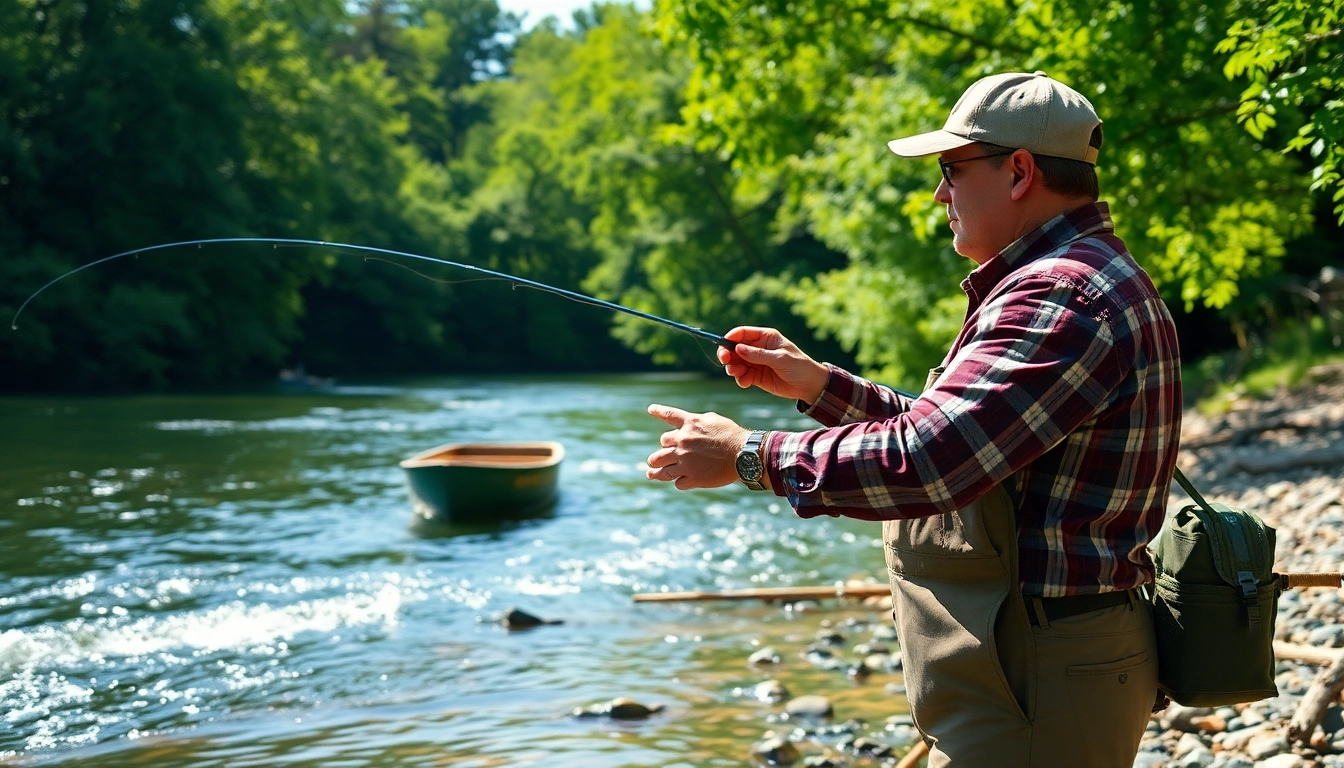
Why Choose Fly Fishing Lessons Near Me?
When considering a new hobby such as fly fishing, the thought of embarking on this journey can feel both exhilarating and daunting. Choosing to take Fly fishing lessons near me opens the door to a plethora of opportunities and benefits that can help you establish a strong foundation in this rewarding sport. Localized instruction not only brings you closer to your potential fishing spots but also connects you with seasoned experts who can impart invaluable knowledge tailored to the environments you’ll be fishing in.
Benefits of Personalized Instruction
One of the primary advantages of taking fly fishing lessons tailored to your local area is personalized instruction. Individualized training allows professionals to assess your current skill level, identify areas for improvement, and create a structured learning experience that aligns with your goals.
Students benefit from hands-on practice under the watchful eyes of experienced instructors, who can immediately correct mistakes, teach proper techniques, and foster confidence. The personal touch makes learning the nuances of fly fishing—like the proper way to cast, select the right flies, and understand water structure—much more enriching.
Local Knowledge and Accessibility
Engaging with local instructors provides an edge that is difficult to replicate through online courses or broad-strokes tutorials. A local expert possesses intimate knowledge of nearby waterways, seasonal fish behavior, and the best times to fish. They can direct you to the most fruitful locations, ensuring that your time on the water is both enjoyable and successful.
This geographical familiarity extends to knowing which fly patterns are effective in specific areas and the best practices for varying weather conditions. Essentially, local instructors can tailor your lessons around what you will encounter on your fishing trips.
Community and Networking Opportunities
Participating in local fly fishing lessons exposes you to a community of like-minded enthusiasts. Many lessons are conducted in group formats, presenting opportunities not only for shared learning but also for forming friendships and networks that can enhance your fishing journey.
Being a part of this community can lead to fishing buddies, tips about upcoming events like tournaments and conservation efforts, and even recommendations for gear. By building such connections, you’re more likely to engage with the sport over the long term.
Understanding the Basics of Fly Fishing
Essential Gear and Equipment for Beginners
Before stepping onto the water, it’s important to understand the basic gear and equipment needed for fly fishing. This includes:
- Fly Rod: Generally longer (8 to 10 feet) than traditional rods, fly rods are designed to cast lightweight flies.
- Fly Reel: This device holds the line and is essential for managing catches.
- Fly Line: Heavier than standard fishing line, fly line helps cast the lightweight flies with accuracy.
- Backing: This is the line attached to the fly line that provides additional length and is essential for larger fish.
- Flies: The artificial bait differentiated into categories such as dry flies, nymphs, and streamers to imitate aquatic insects.
- Waders: Essential for staying dry and comfortable while standing in the water.
- Tools and Accessories: Items such as nippers, a fly box, and a landing net make the fishing experience more efficient.
Basic Casting Techniques Explained
Once equipped, understanding casting techniques is vital for success. Learning to cast properly involves mastering the following:
- The Basic Cast: Hold the rod shoulder height with the line behind you. Use a smooth motion to whip the rod forward, allowing the line to lay out in front.
- The Roll Cast: This is useful when there is limited backspace. Lifting the rod tip and moving it sideways helps pivot the line forward.
- The Double Haul: An advanced technique that involves pulling on the line while casting to increase distance.
Regular practice with these techniques leads to improved accuracy and distance, essential components for effective anglers.
Choosing the Right Fly Patterns
Understanding how to select the right fly patterns can significantly impact your fishing success. Factors influencing fly selection include:
- Fish Species: Different species will respond to various types of flies based on their feeding habits.
- Water Conditions: Water clarity, temperature, and movement can affect the choice of flies.
- Time of Year: Seasonal hatches dictate which insects are available, influencing which flies are most effective.
Consulting local resources and engaging with instructors can significantly enhance your understanding of effective fly patterns for your region.
Finding the Best Fly Fishing Schools Near Me
Criteria for Selecting Quality Instruction
When searching for suitable fly fishing schools, consider the following criteria to ensure you’re receiving the best instruction:
- Instructor Credentials: Look for schools with certified and experienced instructors who have a proven track record in teaching.
- Class Size: Smaller class sizes can offer more personalized attention and improved learning experiences.
- Curriculum Coverage: Ensure the curriculum covers essential topics, including gear selection, casting techniques, and the local fishing environment.
- Practical Experience: Hands-on fishing sessions should be a key component of instruction, providing opportunities to practice skills in real-life situations.
- Feedback and Reviews: Look for testimonials from past students to gauge the effectiveness and satisfaction of the program.
Reviews and Testimonials from Students
Gathering insights from past students concerning their experience can be invaluable. Reviews can shed light on what to expect and where a school excels or has room for improvement. Engage in local fishing forums, social media groups, and websites dedicated to fishing to read up on personal accounts and recommendations.
Comparing Different Learning Formats
Fly fishing education can be approached through various formats, including:
- One-on-One Lessons: Personalized instruction tailored to individual skill levels aimed at achieving personal goals.
- Group Classes: A collaborative environment where students learn from each other’s questions and experiences; often more affordable.
- Workshops and Clinics: Short, intensive courses designed to focus on specific techniques or aspects of fly fishing.
- Online Courses: While less hands-on, these can provide foundational knowledge at your convenience.
Ultimately, choose a format that aligns with your learning preferences and objectives.
Advanced Techniques to Enhance Your Skills
Mastering Casting Accuracy and Distance
Once you have grasped the basics, enhancing your casting accuracy and distance becomes a priority. This can involve:
- Practicing with Targets: Set up targets while practicing to improve accuracy.
- Using the Right Rod Length: Longer rods can aid in casting distance, but you’ll need the right technique to handle them effectively.
- Using Proper Body Mechanics: Engaging your core and utilizing your body movements can significantly impact casting power.
Regular practice and focus on these areas will yield noticeable improvements in your fishing proficiency.
Understanding Aquatic Insects and Their Patterns
A significant component of effective fly fishing is understanding the life cycles of aquatic insects. Familiarizing yourself with these creatures will greatly influence your fly selection. Study local species that fish commonly feed on and pay attention to their seasonal appearances:
- Mayflies: Often abundant during spring and summer, these are a staple in many streams.
- Caddisflies: Present year-round but especially active in warmer months; they come in many varieties.
- Stoneflies: Typically appear in cold water; knowing about them will help in riparian zones.
Regular observation and research of your fishing locations will hone your skill in matching the hatch and picking suitable flies.
Strategic Approaches for Various Water Types
Different water types require distinct fishing strategies:
- Still Water: Techniques here often include presenting flies near vegetation and using slow retrieves.
- Flowing Water: In moving water, consider casting upstream and allowing the fly to drift downward naturally.
- Rapid Water: In fast currents, focusing on pockets where fish might hide will yield better results.
Understanding how different environments affect fish behavior will enhance your strategizing and increase your chances of success on the water.
Staying Inspired and Connected with the Fly Fishing Community
Joining Local Fishing Clubs and Events
To stay inspired, consider joining local fishing clubs and participating in events. Such affiliations provide ongoing education, access to exclusive resources, and camaraderie with other fly fishing enthusiasts. Whether it’s participating in group outings or educational events, the networking potential is vast.
Participating in Conservation Efforts
Engaging in local conservation initiatives fosters a responsible and sustainable approach toward fishing. Many clubs organize clean-up days and advocacy campaigns aimed at preserving local waterways. Being involved in conservation efforts not only helps the environment but also enhances your connection to the craft.
Continued Learning Through Workshops and Seminars
The learning process doesn’t need to end with your initial lessons. Explore workshops and seminars focused on advanced topics like fly-tying, specific fishing techniques, or environmental education. Each opportunity expands your knowledge base and enhances your skill set, ensuring you remain engaged and passionate about fly fishing.






